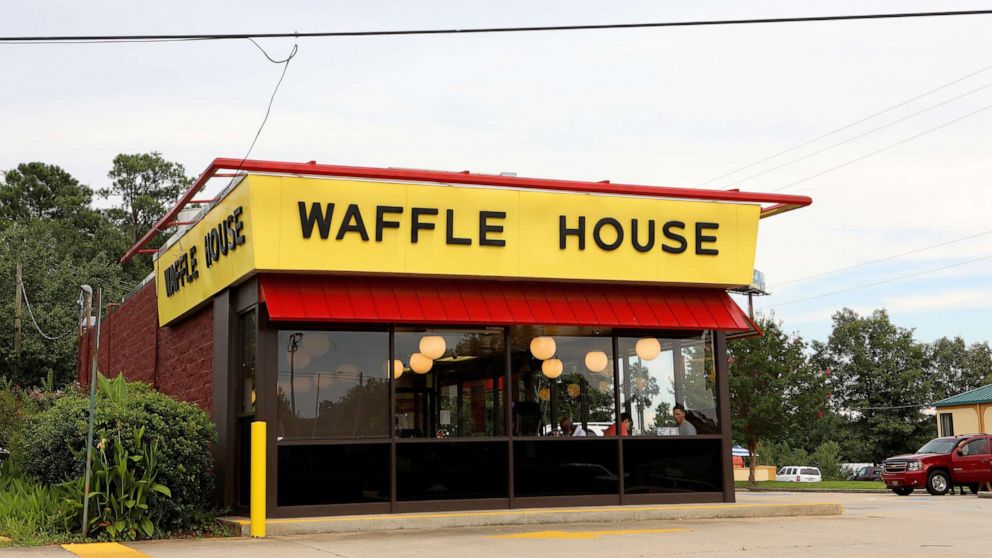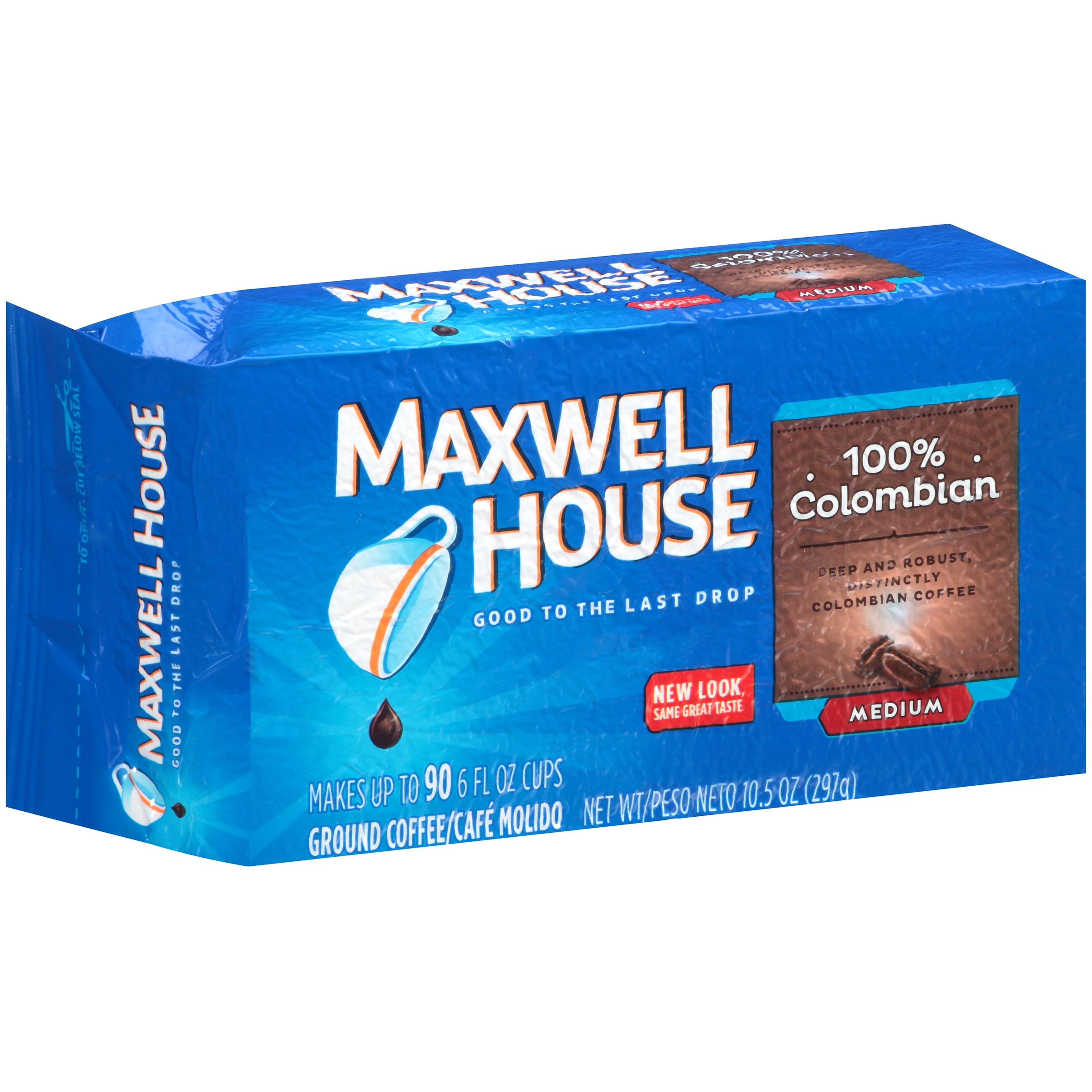Table Of Content

Waffle House uses one main distributor, Illinois-based US Foods, which has depots scattered across the Southeast, where most Waffle Houses are concentrated, and where many hurricanes that strike the U.S. make landfall. So supplies don’t need to travel far in advance of a storm and are close by once roads are clear. FEMA assesses the impact of natural disasters by measuring their interruption of multiple large national chains and informally references a "Waffle House Index."
Learn how the national diner’s closing practices can help measure the severity of a local storm.
Currently, the 10 closed Florida locations include two in Naples, a few in Port Charlotte and several in Fort Myers, Boss says. As Hurricane Ian pummeled Florida's western coast on September 28, 2022, news broke that streets were flooded, houses had been swept away, and Waffle Houses were closing. The last detail seems like an odd thing to focus on—but it’s actually a sign of dire situations.
Article Tags
In May, the two Waffle Houses in Joplin, Mo., were among the few places to stay open after the deadliest tornado in six decades tore through the area. The Waffle House Index is considered accurate in part because it isn’t used to measure specifics but rather to gauge a storm’s impact on a community. What helps its accuracy here is the volume of stores — there are hundreds scattered across the Southeast. Waffle House had no role in creating the index, but it values the "the goodwill gained from being open when customers are most desperate," its website says. Boss adds that the restaurant chain "takes pride" in always being among the first businesses to reopen once it's safe to enter an area devastated by a disaster. In a interview with NBC News on Thursday, Fugate acknowledged that the index "doesn't tell you everything." But he says restaurants labeled red are still a "pretty good gauge" of which areas of a community are impacted the most and need critical attention first.
Does FEMA Use Waffle House Closures to Determine How Bad a Disaster Is?
"We actually have a storm playbook that every restaurant has. We revise it each year as needed. And it tells the management team what to do in the event of an emergency," said Njeri Boss, Vice President of Public Relations for Waffle House. Many of the 1,600 Waffle House locations are in hurricane-prone areas on the East and Gulf Coasts. Waffle House strives to be open when people are desperate – and the chain has proven to be reliable after devastating hurricanes.
Will Hurricane Idalia shut down your Waffle House? Why that matters in a storm - Miami Herald
Will Hurricane Idalia shut down your Waffle House? Why that matters in a storm.
Posted: Tue, 29 Aug 2023 07:00:00 GMT [source]
With Irma’s destruction having been hot on the heels of Harvey, and Maria yet to make its way through the Caribbean, it’s important for everyone to be involved. While fundraising may work for some, other teams—whether professional like the Florida Panthers or collegiate, like the Michigan State Spartans football team have taken to volunteering to help in their off-time.
Muslim Public Affairs Council condemns calls for National Guard to be deployed against protesters
However, the context indicated that Waffle House was one of several large chains observed by FEMA to assess how badly affected an area's operations might be after a national disaster. The well-known restaurant chain currently has 10 locations closed in the hardest hit areas of Florida, a number that will "fluctuate rapidly" as staff works to re-open and aid community members, Waffle House spokesperson Njeri Boss tells CNBC Make It. Waffle House has become a place for residents and first responders to often receive their first meal after a natural disaster, offering a fleeting moment of normalcy for those severely impacted. As those in Hurricane Florence's path begin to recover, the yellow glow of their local Waffle House could likely provide assurance there's a hot meal waiting for them just around the corner.

For Americans to require FEMA's help, whatever happened on the ground must have been quite severe. On top of that, the then newly-reorganized agency's widely-criticized, delayed response to Hurricane Katrina in 2005 left many with the impression FEMA was a bumbling (and at worst, carelessly lethal) example of federal inefficiency. Waffle House closed 21 locations across the state from Naples along the Gulf of Mexico north some 120 miles to Bradenton in Manatee County as a precaution before closing an additional 14 stores. There are a lot of ways the Federal Emergency Management Agency (FEMA) assesses and addresses the severity of a natural disaster. Meteorology can predict movement patterns, wind gusts, and precipitation.
These companies have good risk management plans to ensure that their stores continue to operate when a disaster strikes, and also provide basic supplies to people in their community. For example, if a Waffle House store is open and offering a full menu, the index is green. Because Waffle House is well prepared for disasters, Kouvelis said, it’s rare for the index to hit red. For example, the Joplin, Mo., Waffle House survived the tornado and remained open. As [FEMA Director W. Craig Fugate] often says, the Waffle House test doesn’t just tell us how quickly a business might rebound – it also tells us how the larger community is faring.
Waffle House, which do a significant amount of their business in the South where a frequent amount of hurricanes can take place, have good risk management and disaster preparedness. "We actually have a storm playbook that every restaurant has. We revise it each year as needed. And it tells the management team what to do in the event of an emergency," said Boss.The restaurants have menus for the times they are without water, electricity, and even gas. This combination means the Waffle House Index rarely reaches the red level.
"Waffle House gets open, while everyone else has to wait for the infrastructure to allow them to reopen." "[Starbucks] didn't turn off their Wi-Fi, so people were pulling up to the Starbucks to get access to the internet," Fugate said. The National Voluntary Organizations Active in Disaster offer a list of nearly 60 organizations to choose from—depending on what kinds of missions you support. From veterans continuing their service with Team Rubicon, to trained comfort dogs of Hope Animal Assisted Crisis Response, and a variety of faith-based groups, there is an organization for everyone to love. If you’re looking to donate, monetary donations to trusted organizations are the recommended route to take. Cash donations allow groups flexibility to get the supplies survivors and communities need when they’re needed.
Every location has a wall-mounted “crisis response” flier that includes detachable wallet cards listing personal-preparedness steps for hurricanes, tornadoes and ice storms. That model of staging supplies and personnel in layers outside an emergency, in order to swoop in quickly once it abates, isn’t unique to Waffle House. It’s also followed by the military and by the Centers for Disease Control and Prevention, which oversees the Strategic National Stockpile of emergency medications, vaccines and antidotes for natural disasters and biological attacks. But the Waffle House Index also stands for something less obvious.
Why 'Waffle House Index,' closures became gauge for hurricane impact - Pensacola News Journal
Why 'Waffle House Index,' closures became gauge for hurricane impact.
Posted: Mon, 28 Aug 2023 07:00:00 GMT [source]
“If we're closed after the storm, then that means there's some pretty significant damage that we weren't able to overcome right away and that meant that the community itself probably also would evidence that same kind of damage,” Boss said. By Wednesday night, the index was looking pretty good in places that were hit hard by Hurricane Irene over the weekend. The Journal says that of the company's "22 restaurants in North Carolina, Virginia, Maryland and Delaware ... all but one in hard-hit coastal Virginia were back in business."
The federal government uses many different methods to determine how severe a storm might be, some like Doppler radar from the National Weather Service are incredibly sophisticated. Prior to joining Newsweek in 2018, Ramsey was a multimedia reporter at the local NPR and PBS affiliate WUFT News in Gainesville, Florida. While there, he reported for TV, radio and web, primarily focusing on local and state politics.
Out in the Atlantic Ocean, Hurricane Matthew was hurling winds of 115 miles an hour toward the coast of Florida. Hundreds of miles inland, in the headquarters of Waffle House Inc., Stark’s software predicted that 477 of the chain’s almost 1,900 restaurants might be affected by the onrushing storm. Compounding FEMA's public relations challenge is the fact that FEMA only tends to be involved in times of great distress.
The index has three levels based on the resources available including manpower, power and food. Green indicates a full menu, minimal or no damage and working power. Yellow implies a limited menu as a result of inconsistent power or food supplies running low.
All jokes aside, the Waffle House Index is a very real barometer that is unofficially used by state, local and federal governments to gauge the magnitude of disasters throughout the Southeast. In March 2020, the Waffle House Index went red as restaurants around the U.S. closed during the early weeks of the COVID-19 pandemic. Former FEMA Administrator Craig Fugate is the man behind the infamous Waffle House Index. He spoke to Newsweek on Thursday to tell the story of how a morning ritual and a casual observation turned into a nationwide indicator used by the government and millions of people to assess storm damage.












